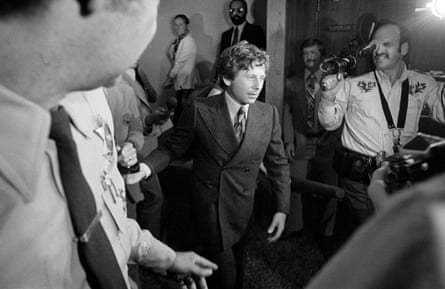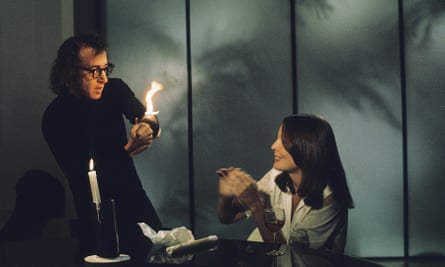WORD NEWS
‘Can I nonetheless take heed to David Bowie?’ A superfan’s dilemma | Books
Five years in the past, in November 2017, I revealed an essay titled What Do We Do With the Artwork of Monstrous Males? It went viral proper on the peak of the #MeToo avalanche. The Harvey Weinstein accusations had simply been made public, adopted by allegations towards the comic Louis CK, senator Al Franken, TV information stars Charlie Rose and Matt Lauer and plenty of extra. All this was set towards the backdrop of the dawning of the Trump period, which was ushered in by the soon-to-be-president’s Entry Hollywood tape, wherein he described grabbing girls by the pussy. Over the subsequent months and years I travelled to school campuses to debate this problem, and located the scholars I spoke to have been as confused as I felt. Might they nonetheless watch Shakespeare in Love? Might they take pleasure in Louis CK in Parks and Recreation? Might they nonetheless take heed to David Bowie?
I’ve spent my life being dissatisfied by beloved male artists: John Lennon hit his first spouse; TS Eliot was antisemitic; Woody Allen started a relationship together with his accomplice’s daughter Quickly-Yi; Roman Polanski pleaded responsible to the statutory rape of 13-year-old Samantha Gailey (now Geimer). After I began to put in writing about this downside, I realised I didn’t need to compile a list of monsters – in any case, wasn’t the historical past of artwork already that? I used to be looking for out not concerning the artists, however concerning the viewers.
These artists did or stated one thing terrible, and had made one thing nice. The terrible factor disrupts the nice work; we will’t watch, or take heed to, or learn the nice work with out remembering the terrible factor. Flooded with data of the maker’s monstrousness, we flip away, overcome by disgust. Or … we don’t. We proceed watching, separating or making an attempt to separate the artist from the artwork. Both approach: disruption. Polanski had develop into not his personal downside, however my downside.
I needed somebody would invent an internet calculator – the person would enter the title of an artist, whereupon the calculator would assess the heinousness of the crime versus the greatness of the artwork and spit out a verdict: you might or couldn’t devour the work of this artist. A calculator is laughable, unthinkable. But our ethical sense have to be made to return into stability with our art-love. I needed for there to be a common stability, a common reply, although I suspected that this stability is totally different for everybody.

We don’t at all times love whom or what we’re supposed to like. Allen himself famously quoted Emily Dickinson: “The guts desires what it desires.” WH Auden stated it extra properly, as he stated virtually every part extra properly: “The wishes of the center are as crooked as corkscrews.” We proceed to like what we should hate. We are able to’t appear to show the love off.
That’s not how everybody sees it, although. After I began to discover this downside, I found that male critics needed the work to stay untouched by the life. The voice of authority says biography is fallacy. Authority believes the work exists in a super state (ahistorical, alpine, snowy, pure). Authority ignores the pure feeling that arises from biographical data of a topic. Authority will get snippy about stuff like that. Authority claims it is ready to recognize the work freed from biography, of historical past. Authority sides with the male maker, towards the viewers.
However, after all, we don’t resolve to have the biography disrupt the work; it merely occurs. The work is modified. And so a monster turned, in my thoughts, an artist who merely couldn’t be separated from some darkish facet of their biography. However the phrase “monster” was maybe not the proper appellation to comprise the complexity of that concept and the shortcomings of the time period have been clarified to me in the future once I was messaging with a music critic about Michael Jackson. He requested, about Jackson, after the Leaving Neverland documentary had detailed the abuse described by Jackson’s accusers: “Does the stain work its approach backwards by way of time?”
This picture of the stain instantly took maintain of my mind. The phrase “monster” is sort of a suitcase packed filled with rage – the craze that offers rise to the phrase’s utterance, the craze with which it’s heard, whether or not by pal or foe of the monster in query. The stain is one thing else once more. The stain is simply plain unhappy. Indelibly unhappy. Nobody desires the stain to occur. It simply does.

A few weeks later, I used to be consuming breakfast at a diner once I Need You Again by the Jackson 5 got here on. I bopped just a little on my stool, I couldn’t assist it. I discovered it onerous to withstand the pull of the music, borne on the air. And but the second was ruined too. I used to be placidly forking hash browns and all of the whereas feeling like one thing horrible was (form of) taking place.
That’s how the stain works. The biography colors the track, which colors the sunny second of the diner. When somebody says we should separate the artwork from the artist, they’re saying: “Take away the stain.” Let the work be unstained. However that’s not how stains work. We watch the glass fall to the ground; we don’t get to resolve whether or not the wine will unfold throughout the carpet.
The stain begins with an act, a second in time, however then it travels from that second, like a teabag steeping in water, colouring your complete life. The precept of retroactivity implies that in the event you’ve accomplished one thing sufficiently asshole-like, it follows that you simply have been an asshole all alongside. A lady says what occurred to her, an abuse is revealed, and the stain travels backward, affecting and defining the perpetrator not simply on the time of the abuse, and never simply after the abuse, however earlier than he dedicated the crime.
Unusual idiosyncratic private guidelines come up from such data – I’ve a a lot simpler time watching movies that Polanski made earlier than he raped Samantha Gailey. And but on the identical time, Polanski – predator, statutory rapist – collapses into Polanski the preternaturally proficient Polish artwork scholar, wunderkind, Holocaust survivor. Once we stream his 1962 psychological thriller, Knife within the Water, we want we might give our few {dollars} to that innocent younger Polanski. We surprise: how can we bypass this horrible previous prison? We are able to’t. We are able to’t even bypass our data of what he’s accomplished. We are able to’t bypass the stain. It colors the life and the work.
We would need to overlook the stain – depart behind, or by no means purchase, this horrible data of the maker’s biography. However there is no such thing as a longer any escaping biography. Even inside my very own lifetime, I’ve seen a large shift. Biography was once one thing you sought out, yearned for, actively pursued. Now it falls in your head all day lengthy. Now it appears not possible to shake work free from biography. We swim in biography; we’re sick with biography.
A truism of our second in historical past is that we reside within the time of the fan. As biography rises, as its shadow, cancel tradition, escalates, fan tradition additionally ascends. But this fandom, mysteriously, doesn’t make us extra more likely to prioritise the work over the biography. When what you want turns into essential, turns into defining, turns into an obsession, then an artist’s biography has much more energy than earlier than. You haven’t simply admired, not simply consumed the artwork, you’ve develop into it. And due to this fact you will have some new, a lot nearer relationship with its maker.

The significance of our relationship with the artist’s biography is reaffirmed all over the place and on a regular basis. Its sign high quality is intimacy. The widespread use of the phrase “parasocial relationship”, a beforehand obscure sociological time period that’s being batted concerning the web with better and better frequency, displays the rising prevalence of the phenomenon it describes: the idea that we’ve got actual emotional connections with the artists whose work we love.
after newsletter promotion
We all know how this feels. It’s a different feeling from simply loving an artist’s work – it’s the feeling that you know this artist personally, as a friend, and what’s more, they possess the same knowledge of you. It’s a piece of obviousness that the internet has exacerbated this false-yet-extremely-real-feeling connection; indeed it could be said that this feeling of connection is the main product of social media; the commodity it is selling and reselling. And yet. It feels so real.
All of this is to say: when I come to this question – the question of what to do with the art of monstrous men – I don’t come as an impartial observer. I’m not someone who is absent a history. I have been a teenager predated by older men; I have been molested; I’ve been assaulted on the street; I’ve been grabbed and I’ve been coerced and I’ve escaped from attempted rape. I don’t say this because it makes me special. I say it because it makes me non-special. And so, like many or most women, I have a dog in this particular race.
I don’t come to these questions with a dispassionate point of view. I come as a sympathiser to the accusers. I am the accusers. And yet I still want to consume the art. Because, out in front of all of that, I’m a human. And I don’t want to miss out on anything. Why should I? Why should I be deprived of Polanski’s Chinatown or Woody Allen’s Sleeper? This tension – between what I’ve been through as a woman and the fact that I want to experience the freedom and beauty and grandeur and weirdness of great art – this is at the heart of the matter. It’s not a philosophical query; it’s an emotional one.
Your aesthetic experience may, in fact, be the opposite of disinterested; it might be deeply emotionally interested. Lived experience expands and illuminates the art we take in. Nostalgia, personal experience – these things become meaningful in terms of calculating the badness of the act against the greatness of the work. My answer is different from yours. I didn’t dance to R Kelly at my wedding reception; maybe you did. Maybe you want to revisit that memory. I didn’t imprint on the Black excellence represented by Bill Cosby’s Dr Huxtable; maybe you did. Maybe you need that image.
When Bowie died in 2016, I didn’t know how to express my feelings about his death or the magnitude of my love for him. I posted a couplet from his song “Five Years” (“Your face, your race, the way that you talk / I kiss you, you’re beautiful, I want you to walk”) and spent a few days going around feeling lower than I had any right to.

But then, in the weeks following his death, stories started to appear. An interview that the groupie Lori Mattix had given in 2015 resurfaced, telling how she lost her virginity to Bowie at the age of 15. Mattix didn’t begrudge Bowie her virginity; in fact she spoke of the incident in rhapsodic language: “I was an innocent girl, but the way it happened was so beautiful … Who wouldn’t want to lose their virginity to David Bowie?” I believed her, and I was left feeling horrified and sad.
This, then, is the very, very specific thing that students want to know: can they listen to David Bowie? The question is urgent. They need him. Young people are not dealing with nostalgia. They’re dealing with their own all-too-current feelings. For teenagers, music makes a kind of repository for feelings. So a betrayal by a musician becomes all the more painful – it’s like being betrayed by your own inner self.
Bowie was important to me in the same way when I was a weird kid. David Bowie was, in fact, the patron saint of weird kids. I played Bowie’s fourth album, Hunky Dory, every day in 10th grade – it seemed to stave off the inexplicable howling aloneness – and then my daughter did the same. For kids like me, there was a sense of ownership; Bowie was ours. His very existence was an assertion that aliens walked among us, so that when we ourselves felt alien, we might take comfort in the idea that we lived among a secret race, our true family. I brought all that to my listening to Bowie; I brought it as well to my digestion of the news of his stain.
This is what I tell the students: consuming a piece of art is two biographies meeting: the biography of the artist that might disrupt the consuming of the art; the biography of the audience member that might shape the viewing of the art. Your biography, your feelings are important. Not just your feelings of abhorrence for the deed, but your love for the work. The sense of beauty it brings into your life. Beauty is a fragile principle. It looks silly when it’s brought up against utility – or morality. When we mull over what to do about the art of monstrous men, beauty seems like a dandelion puff – the merest nothing – next to the loud j’accuse of saying how awful these men were in their personal lives. And yet. Beauty matters too. We don’t make decisions about beauty. Like the stain, beauty happens to us.
Trending
-
Bank and Cryptocurrency12 months ago
Cheap Car Insurance Rates Guide to Understanding Your Options, Laws, and Discounts
-
Bank and Cryptocurrency12 months ago
Why Do We Need an Insurance for Our Vehicle?
-

 entertainement6 months ago
entertainement6 months agoHOUSE OF FUN DAILY GIFTS
-
WORD NEWS1 year ago
Swan wrangling and ‘steamy trysts’: the weird lives and jobs of the king’s entourage | Monarchy
